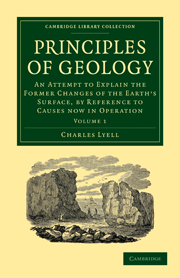 Principles of Geology
Principles of Geology As the proofs enumerated in the last chapter indicate that the earth's surface has experienced great changes of climate since the deposition of the older sedimentary strata, we have next to inquire, how such vicissitudes can be reconciled with the existing order of nature. The cosmogonist has availed himself of this, as of every obscure problem in geology, to confirm his views concerning a period when the laws of the animate and inanimate world were wholly distinct from those now established; and he has in this, as in all other cases, succeeded so far, as to divert attention from that class of facts, which, if fully understood, might probably lead to an explanation of the phenomenon. At first, it was imagined that the earth's axis had been for ages perpendicular to the plane of the ecliptic, so that there was a perpetual equinox, and unity of seasons throughout the year:—that the planet enjoyed this ‘paradisiacal’ state until the era of the great flood; but in that catastrophe, whether by the shock of a comet, or some other convulsion, it lost its equal poize, and hence the obliquity of its axis, and with that the varied seasons of the temperate zone, and the long nights and days of the polar circles. When the advancement of astronomical science had exploded this theory, it was assumed, that the earth at its creation was in a state of fluidity, and red hot, and that ever since that era it had been cooling down, contracting its dimensions, and acquiring a solid crust, an hypothesis equally arbitrary, but more calculated for listing popularity, because, by referring the mind directly to the beginning of things, it requires no support from observations, nor from any ulterior hypothesis.
To save this book to your Kindle, first ensure no-reply@cambridge.org is added to your Approved Personal Document E-mail List under your Personal Document Settings on the Manage Your Content and Devices page of your Amazon account. Then enter the ‘name’ part of your Kindle email address below. Find out more about saving to your Kindle.
Note you can select to save to either the @free.kindle.com or @kindle.com variations. ‘@free.kindle.com’ emails are free but can only be saved to your device when it is connected to wi-fi. ‘@kindle.com’ emails can be delivered even when you are not connected to wi-fi, but note that service fees apply.
Find out more about the Kindle Personal Document Service.
To save content items to your account, please confirm that you agree to abide by our usage policies. If this is the first time you use this feature, you will be asked to authorise Cambridge Core to connect with your account. Find out more about saving content to Dropbox.
To save content items to your account, please confirm that you agree to abide by our usage policies. If this is the first time you use this feature, you will be asked to authorise Cambridge Core to connect with your account. Find out more about saving content to Google Drive.